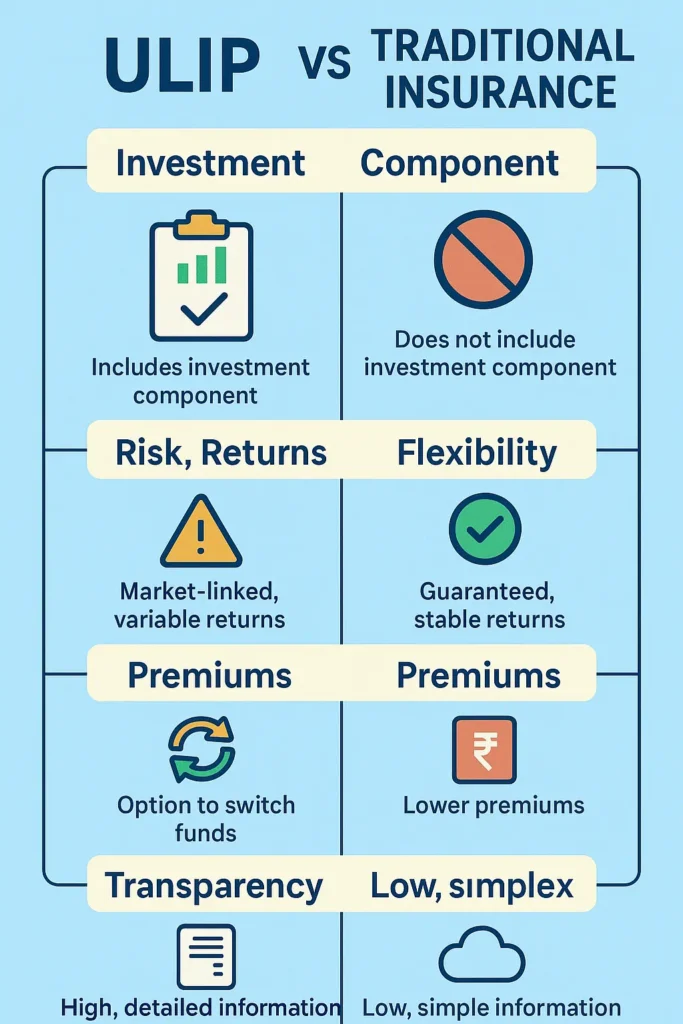
Choosing the right insurance plan can be confusing, especially with so many options available. Should you go for a Unit Linked Insurance Plan (ULIP), which combines investment and insurance, or opt for a Traditional Insurance Plan, which offers guaranteed returns and financial security?
Both have their advantages and drawbacks, and the right choice depends on your financial goals, risk appetite, and investment preferences. In this article, we’ll break down ULIP vs Traditional Insurance in simple terms so you can make an informed decision.
What is ULIP?
A Unit Linked Insurance Plan (ULIP) is an insurance plan that also acts as an investment. A part of your premium goes towards providing life insurance coverage, while the rest is invested in market-linked funds like equity, debt, or balanced funds. ULIP vs Traditional Insurance is a common debate, and understanding how ULIPs work can help make a better decision.
How ULIPs Work
-
Your premium is split into two parts: one for life cover and the other for investment.
-
You can choose where to invest—equity funds (high risk, high returns), debt funds (low risk, stable returns), or balanced funds (moderate risk, balanced returns).
-
ULIP vs Traditional Insurance considerations include the fact that ULIPs come with a five-year lock-in period, meaning you can’t withdraw your money before that.
-
You can switch between funds based on market trends and financial goals.
Who Should Consider ULIPs?
-
If you want both insurance and investment in one plan.
-
If you are willing to take some market risks for potentially higher returns.
-
If you’re planning for long-term goals like retirement or your child’s education.

What is Traditional Insurance?
Traditional insurance focuses purely on financial protection. It does not offer market-linked returns but guarantees a lump sum or fixed payout. ULIP vs Traditional Insurance discussions often highlight that traditional insurance provides more security with lower risk.
Types of Traditional Insurance Plans
-
Term Insurance – Provides high coverage at a low cost but no maturity benefits.
-
Endowment Plans – Offers both insurance coverage and a lump sum maturity benefit.
-
Whole Life Insurance – Provides coverage for the policyholder’s entire life.
-
Money-Back Plans – Gives periodic payouts during the policy term.
Who Should Consider Traditional Insurance?
-
If you prefer guaranteed returns and financial security.
-
If you are a risk-averse investor.
-
If you want a long-term savings plan with predictable benefits.
Key Differences Between ULIP and Traditional Insurance
| Factor | ULIP | Traditional Insurance |
|---|---|---|
| Purpose | Insurance + Investment | Pure Protection or Savings-Based |
| Returns | Market-linked (Higher Potential) | Guaranteed but Lower Returns |
| Risk Level | Medium to High (depends on market) | Low to None |
| Flexibility | Can switch funds | Fixed returns, no investment flexibility |
| Lock-in Period | 5 years | Varies depending on the policy type |
| Transparency | Clearly defined charges and returns | Less transparent with hidden costs |
| Liquidity | Partial withdrawal allowed after 5 years | Limited liquidity, loans available against policy |
| Best for | Growth-oriented investors | Risk-averse investors |
Pros and Cons of ULIP
✅ Pros:
-
Combines insurance and investment in one plan.
-
Lets you choose where to invest (equity, debt, or balanced funds).
-
Offers potentially higher returns over time.
-
Allows fund-switching to manage risks.
-
Provides tax benefits under Section 80C and 10(10D).
❌ Cons:
-
Market fluctuations can affect returns.
-
Higher charges (mortality charge, fund management charge, etc.).
-
Five-year lock-in period before you can withdraw money.
Pros and Cons of Traditional Insurance
✅ Pros:
-
Ensures financial security with guaranteed benefits.
-
Low-risk investment, ideal for conservative investors.
-
Stable, long-term returns.
-
Provides tax benefits under Section 80C and 10(10D).
❌ Cons:
-
Returns are lower than ULIPs.
-
No flexibility or control over investments.
-
Limited liquidity—you can’t withdraw money easily.
Which One Should You Choose?
The choice between ULIP vs Traditional Insurance depends on your financial needs and how much risk you are willing to take.
-
Choose ULIP if:
-
You want to grow your wealth while staying insured.
-
You are comfortable with market fluctuations.
-
You want flexibility in investment choices.
-
You have a long-term financial goal.
-
-
Choose Traditional Insurance if:
-
You want guaranteed, risk-free returns.
-
You prefer financial protection over investment.
-
You want a stable savings plan.
-
Frequently Asked Questions (FAQs)
-
Which is better, ULIP or Traditional Insurance?
-
It depends on your goals. If you want investment growth along with insurance, go for ULIP. If you want guaranteed returns, choose Traditional Insurance.
-
-
Are ULIPs risky?
-
Yes, ULIPs are market-linked, so they carry some risk, but they also have the potential for higher returns.
-
-
Can I withdraw money from ULIP before 5 years?
-
No, ULIPs have a mandatory lock-in period of 5 years before withdrawals are allowed.
-
-
Do ULIPs have hidden charges?
-
ULIPs have charges like fund management fees, mortality charges, and premium allocation fees, but they are transparently mentioned.
-
-
Are Traditional Insurance plans good for wealth creation?
-
No, Traditional Insurance plans focus on financial security rather than high returns.
-
-
Can I switch funds in ULIP?
-
Yes, ULIPs allow you to switch between equity, debt, and balanced funds.
-
-
Do ULIPs and Traditional Insurance both offer tax benefits?
-
Yes, both offer tax benefits under Section 80C and Section 10(10D).
-
-
Which plan is better for retirement planning?
-
ULIPs are better if you seek higher returns over the long term, whereas Traditional Insurance is safer if you prefer guaranteed benefits.
-
-
Can I take a loan against my Traditional Insurance policy?
-
Yes, some Traditional Insurance plans allow loans against the policy.
-
-
What happens if I stop paying my ULIP premium?
-
If you stop paying within the first 5 years, the policy may lapse or get converted to a discontinued fund.
Conclusion
Both ULIP vs Traditional Insurance have their own benefits. If you want to build wealth along with insurance coverage, ULIPs can be a good choice. If you prefer financial security with guaranteed returns, a traditional plan might be better.
Before making a decision, compare different policies, check the terms, charges, returns, and liquidity, and consider what aligns best with your financial goals.
Also Read This
Life Insurance for Over 60s in the UK: Protecting Your Loved Ones
Why Should Health Insurance Be Mandatory In 2025 ?
Home Insurance for Second Home in the UK: Smart Ways to Shield Your Second Home

